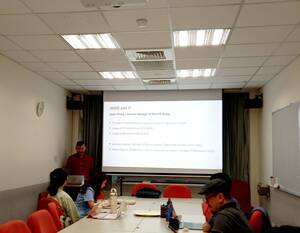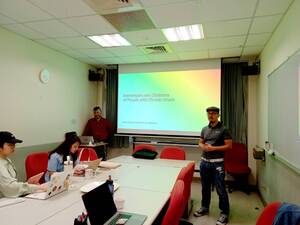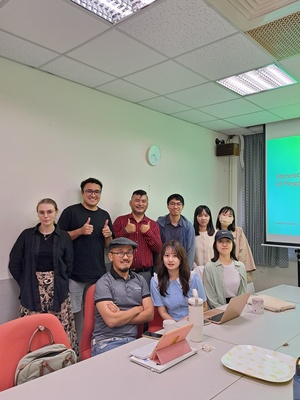Encountering Chronic Illness: Possible Stereotypes and Obstacles




Date :
2024-06-06
Department :
International Master's Program in International Communication Studies
【Article by IMICS】
Encountering Chronic Illness: Possible Stereotypes and Obstacles On May 28, 2024, Jason Chang, the General Manager of the Elite PR Group, delivered a thought-provoking guest lecture on “Stereotypes and Obstacles of People with Chronic Illness.” This speech was part of the Portrayals of Minorities in Media course in the International Master’s Program in International Communication Studies (IMICS), instructed by Dr. Chiahsin Yeh.
Chang commenced the speech by defining health communication as “the study and use of communication strategies to inform and influence individual and community decisions that enhance health.” He emphasized that the essence of this field lies in the gradual transformation of the attitudes and behaviors among message recipients. To support his claim, Chang highlighted three key outcomes illustrating why stereotypes are significant obstacles in healthcare: ignoring abnormal conditions or symptoms, portraying oneself as sad and pitiable, and stigmatized prejudice. These results not only interfere with early diagnosis of chronic illnesses, but also counteract subsequent treatment and recovery of those who suffer those diseases.
Focusing on mental health, Chang discussed how suicide remains a taboo topic and why it is associated with negative portrayals, especially in Asian countries. He played two video clips with identical contents but different background music – brisky versus melancholic – encouraging students to reflect on their feelings about the issue under the two musical setups. This interactive session highlighted the significance of the fact that “suicidal individuals do not always appear suicidal.” Images related to depression and suicide often depict sadness and evoke sympathy, yet the video showing happy moments of people who have attempted suicide starkly contrasted media representation with social reality. “Constant love and care for those around us can positively shift the negative image associated with suicide,” concluded Chang.
Regarding chronic illness, Chang showcased how the Elite PR Group successfully launched campaigns aimed at raising public awareness about diabetes and reducing the stigma associated with insulin use, by means of the persuasive technique as ‘testimonial.’ As detailed in The Fine Art of Propaganda, written by Alfred McClung Lee, this method involves endorsements by celebrities or respected figures, such as the former President Deng-Hui Li, who conquered diabetes and lived to the age of 97, making the campaign much more convincing. As a result, insulin usage increased by 16%, and the number of patients adopting insulin for treatment rose by 18%.
The ‘Questions & Answers’ session brought the event to a meaningful close. One student, Samuel Li, asked about the driving factors for promoting awareness in healthcare-related issues. The lecturer acknowledged the importance of this question by adding that “an effective campaign is about producing echoing messages.” This underscores the significance of resonance and relatability in health communications.
The Portrayals of Minorities in Media course at IMICS aims to equip students with a nuanced understanding of the media portrayals of various minority groups. By comparing media representations and addressing the social issues affecting minorities, as well as exploring the ideologies underlying language use and attitudes, the course is designed to help students recognize and understand stereotypes about each minority group. Additionally, it aims to develop students’ sensitivity and empathy towards minorities, reduce potential cognitive dissonance, and enhance their ability to conduct research on minority issues.
Encountering Chronic Illness: Possible Stereotypes and Obstacles On May 28, 2024, Jason Chang, the General Manager of the Elite PR Group, delivered a thought-provoking guest lecture on “Stereotypes and Obstacles of People with Chronic Illness.” This speech was part of the Portrayals of Minorities in Media course in the International Master’s Program in International Communication Studies (IMICS), instructed by Dr. Chiahsin Yeh.
Chang commenced the speech by defining health communication as “the study and use of communication strategies to inform and influence individual and community decisions that enhance health.” He emphasized that the essence of this field lies in the gradual transformation of the attitudes and behaviors among message recipients. To support his claim, Chang highlighted three key outcomes illustrating why stereotypes are significant obstacles in healthcare: ignoring abnormal conditions or symptoms, portraying oneself as sad and pitiable, and stigmatized prejudice. These results not only interfere with early diagnosis of chronic illnesses, but also counteract subsequent treatment and recovery of those who suffer those diseases.
Focusing on mental health, Chang discussed how suicide remains a taboo topic and why it is associated with negative portrayals, especially in Asian countries. He played two video clips with identical contents but different background music – brisky versus melancholic – encouraging students to reflect on their feelings about the issue under the two musical setups. This interactive session highlighted the significance of the fact that “suicidal individuals do not always appear suicidal.” Images related to depression and suicide often depict sadness and evoke sympathy, yet the video showing happy moments of people who have attempted suicide starkly contrasted media representation with social reality. “Constant love and care for those around us can positively shift the negative image associated with suicide,” concluded Chang.
Regarding chronic illness, Chang showcased how the Elite PR Group successfully launched campaigns aimed at raising public awareness about diabetes and reducing the stigma associated with insulin use, by means of the persuasive technique as ‘testimonial.’ As detailed in The Fine Art of Propaganda, written by Alfred McClung Lee, this method involves endorsements by celebrities or respected figures, such as the former President Deng-Hui Li, who conquered diabetes and lived to the age of 97, making the campaign much more convincing. As a result, insulin usage increased by 16%, and the number of patients adopting insulin for treatment rose by 18%.
The ‘Questions & Answers’ session brought the event to a meaningful close. One student, Samuel Li, asked about the driving factors for promoting awareness in healthcare-related issues. The lecturer acknowledged the importance of this question by adding that “an effective campaign is about producing echoing messages.” This underscores the significance of resonance and relatability in health communications.
The Portrayals of Minorities in Media course at IMICS aims to equip students with a nuanced understanding of the media portrayals of various minority groups. By comparing media representations and addressing the social issues affecting minorities, as well as exploring the ideologies underlying language use and attitudes, the course is designed to help students recognize and understand stereotypes about each minority group. Additionally, it aims to develop students’ sensitivity and empathy towards minorities, reduce potential cognitive dissonance, and enhance their ability to conduct research on minority issues.
